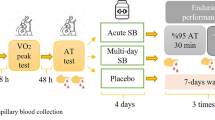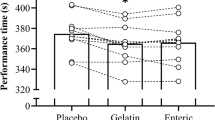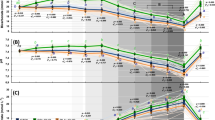Summary
In an effort to determine the effects of bicarbonate (NaHCO3) ingestion on exercise performance, ten male college swimmers were studied during five different trials. Each trial consisted of five 91.4m (100-yd) front crawl swims with a two-minute rest interval between each bout. The trials consisted of two NaHCO3 treatments, two placebo trials and one test with no-drink. One hour before the onset of swimming, the subjects were given 300 ml of citric acid flavored solution containing either 17 mmol of NaCl (placebo) or 2.9 mmol of NaHCO3 · kg−1 body weight (experimental), or received no drink (no-drink). Performance times for each 91.4 m swim were recorded. Blood samples were obtained before and one hr after treatment, two min after warmup, and two min after the final 91.4 m sprint. Blood pH, lactate, standard bicarbonate (SBC) and base excess (BE) were measured. No differences were found for performance or the blood measurements between the placebo and no-drink trials. Bicarbonate feedings, on the other hand, produced a significant (P<0.05) improvement in performance on the fourth and fifth swimming sprints. Blood lactate, pH, SBC and BE were significantly higher (P<0.05) at post-exercise in NaHCO3 treatments. These data are in agreement with previous findings that during repeated bouts of exercise pre-exercise administration of NaHCO3 improves performance, possibly by facilitating the efflux of hydrogen ions from working muscles and thereby delaying the onset of fatigue.
Similar content being viewed by others
References
Costill DL, Kovaleski J, Porter D, Kirwan J, Fielding R, King D (1985) Energy expenditure during front crawl swimming: Predicting success in middle-distance events. Int J Sports Med 6:266–270
Costill DL, Verstappen F, Kuipers H, Janssen E, Fink W (1984) Acid-Base balance during repeated bouts of exercise: influence of HCO3. Int J Sports Med 5:228–231
Dawson MJ, Gadian DC, Wilkie DR (1978) Muscular fatigue investigated by phosphorus nuclear magnetic resonance. Nature 274:861–866
Hermansen L (1981) Effect of metabolic changes on force generation in skeletal muscle during maximal exercise. In: Human muscle fatigue: physiological mechanisms. Pitman Medical, London (Ciba Foundation symposium 82) pp 75–88
Jackson AS, Pollock ML (1978) Generalized equations for predicting body dinsity of men. Br J Nutr 4:497–504
Johnson WR, Black DH (1953) Comparison of effects of certain blood alkalinizers and glucose upon competitive endurance performance. J Appl Physiol 5:577–578
Jones NL, Sutton JR, Taylor R, Toews CJ (1977) Effect of pH on cardiorespiratory and metabolic responses to exercise. J Appl Physiol 43:959–964
Kindermann W, Keul J, Huber G (1977) Physical exercise after induced alkalosis (bicarbonate or tris-buffer). Eur J Appl Physiol 37:197–204
Kowalchuk JM, Heigenhauser GJF, Jones NL (1984) Effect of pH on metabolic and cadiorespiratory responses during progressive exercise. J Appl Physiol 57:1558–1563
Lowry OH, Passonneau JV (1972) A Flexible System of Enzymatic Analysis. Academic Press, New York, pp 194–195
Mainwood GW, Cechetto D (1980) The effect of bicarbonate concentration on fatigue and recovery in isolated rat diaphragm. Can J Physiol Pharmacol 58:624–632
McCartney N, Heigenhauser GJF, Jones NL (1983) Effects of pH on maximal power output and fatigue during shortterm dynamic exercise. J Appl Physiol 55:225–229
Poulus AJ, Docter HJ, Westra HG (1974) Acid-base balance and subjective feelings of fatigue during physical exercise. Eur J Appl Physiol 33:207–213
Robin ED (1961) Of men and mitochondria: intracellular and subcellular acid-base relations. New Engl J Med 265:780–785
Siggard-Anderson O (1976) The acid-base status of blood 4th ed. Williams and Williams Co, Baltimore, p 62
Spriet LL, Lindinger MI, Heigenhauser GJF, Jones NL (1986) Effects of alkalosis on skeletal muscle metabolism and performance during exercise. Am J Physiol 251:R833-R839
Wijnen S, Verstappen F, Kuipers H (1984) The influence of intravenous NaHCO3-admmistration of interval exercise: acid-base balance and endurance. Int J Sports Med [Suppl] 5:130–132
Wilkes D, Gledhill N, Smyth R (1983) Effect of acute induced metabolic alkalosis on 800-m racing time. Med Sci Sports Exerc 75:277–280
Author information
Authors and Affiliations
Rights and permissions
About this article
Cite this article
Gao, J., Costill, D.L., Horswill, C.A. et al. Sodium bicarbonate ingestion improves performance in interval swimming. Europ. J. Appl. Physiol. 58, 171–174 (1988). https://doi.org/10.1007/BF00636622
Accepted:
Issue Date:
DOI: https://doi.org/10.1007/BF00636622




